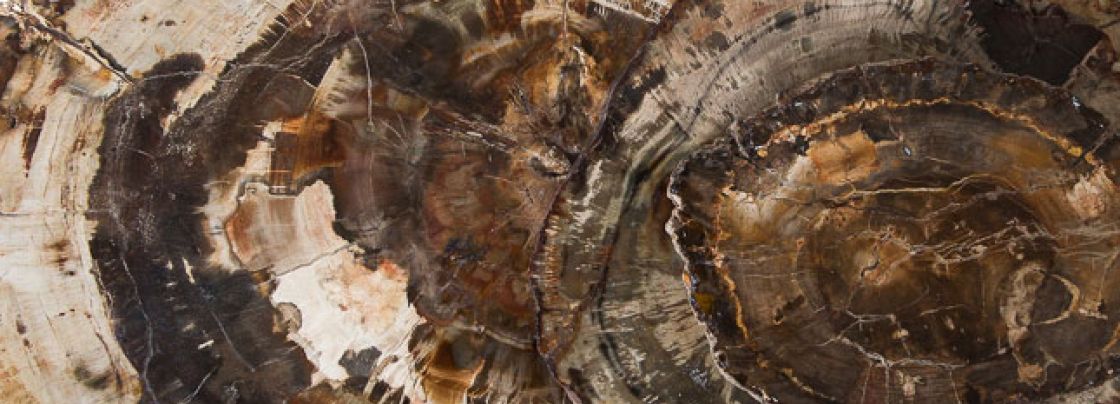Fossil Wood Also known as 'petrified wood'
Fluorite Jasper
How did fossilwood or petrified wood form?
Most fallen trees rot away completely, leaving no trace of their presence BUT petrification of the trunk could occur when the tree fell over in old age (or was wind blown or washed down into a river bed during seasonal floods – or was even pushed over by a dinosaur!). If the trunk became completely covered in sediment, excluding oxygen and was in an area where mineral rich water was flowing through the sediment, mineralization would gradually have taken place. Deposits of minerals (usually silicon dioxide / agate) would replace the organic lignin and cellulose in the plant cells, forming solid fossil wood. Some petrified wood is formed in areas smothered in volcanic ash, e.g., the Petrified Forest on the island of Lesbos, Greece.
What produces the range of colours found in fossilwood?
If minerals are dissolved in the water flowing around the trunks, their characteristic colours may appear in the fossilwood.
For example:
Silica: Grey, white
Manganese oxides: Black
Manganese: Pink, orange
Iron oxides: Red, yellow, brown
Copper, chromium, cobalt: Green, blue
Surprisingly, fossilwood makes extremely attractive spheres and some other worked products. Fossilwood sometimes occupies the borderlands between rocks and crystals, especially when slices include exquisite areas of individual crystals.
Can the tree’s growth rings be seen?
Some fossil wood specimens show areas of preserved annual growth rings in horizontal cross-sections of the trunk. These recorded the growth of the tree, each ring representing the annual increase in the tree’s girth. Trees that grew in areas of the world with big seasonal differences between winter and summer show these more clearly than those growing in tropical regions where growth can take place all year. Often details of the bark are beautifully preserved.
Which species of trees have been found?
Many Conifers (and broadleaved species which evolved later) have been found in various sites around the world and have given valuable evidence of climates of the past – for example, much of the fossilwood found in Arizona is from the Araucariaceae family (the 'monkey puzzle' family). This family is now extinct in the wild in the northern hemisphere but flourished there when the climate was considerably warmer and wetter than experienced today.
How old is fossil wood?
The oldest specimens found are thought to date back 250–200 million years ago to late-Triassic times. Far younger samples have also been discovered, such as the Lesbos find which is thought to be only 20–15 million years old.
What sized pieces have been found?
Probably the largest specimens have come from the Santa Cruz area of southern Argentina with trunks measuring up to 30m (100’) long and 3m (10’) in diameter. That petrified forest has been, understandably, classified as a National Monument! The Petrified Forest of Lesbos covers an area of over 150 square kilometres and even includes large upright trunks with root systems still in place.
How hard is fossil wood?
Fossil wood is graded as 7 on the Mohs scale (the same as quartz due to its silica content).
Our sources
Crystals (UK) has been obtaining its supplies of very varied and fascinating specimens from Madagascar for many years. We aim to stock both large slices with particularly fine colouring and detail as well as smaller pieces showing lovely bark textures.
For many years, Crystals (UK) sourced fossilwood from Australia. The prospector and land-owner benefitted equally and it was practice to fill in a trunk being worked on below the surface to prevent other prospectors finding it.
Unusual fossilwood facts!
• In the Petrified Forest National Park in north-east Arizona, you can find an Agate House and Agate Bridge – both built of petrified wood.
• The Petrified Forest was a 1936 gangster thriller film, starring Bette Davis, which used a petrified forest as an ‘unusual setting’!
- Month stones
- January - Garnet also Ruby
- February - Amethyst also Bloodstone
- March - Aquamarine also Jade
- April - Quartz also Opal
- May - Rose Quartz also Agate
- June - Pearl also Moonstone
- July - Ruby also Carnelian
- August - Peridot also Sardonyx
- September - Iolite also Lapis Lazuli
- October - Opal also Pink Tourmaline
- November - Topaz also Citrine
- December - Turquoise also Tanzanite
- Zodiac Stones
- Capricorn (Dec 22-Jan 19) Amber, Carnelian, Garnet, Onyx, Smoky Quartz, Turquoise
- Aquarius (Jan 20-Feb 18) Aquamarine, Amethyst, Amber, Celestite, Fluorite, Labradorite
- Pisces (Feb 19-Mar 20) Moonstone, Amethyst, Aquamarine, Blue Lace Agate, Fluorite, Turquoise
- Aries (Mar 21-Apr 19) Ruby, Aventurine, Bloodstone, Carnelian, Garnet, Kunzite
- Taurus (Apr 20-May 20) Azurite, Kyanite, Lapis Lazuli, Malachite, Rhodonite, Tigers Eye
- Gemini (May 21-Jun 20) Chrysocolla, Citrine, Serpentine, Tourmalinated and Rutilated Quartz, Tiger's Eye
- Cancer (Jun 21-Jul 22) Moonstone, Pearl, Opal, Ruby, Moss Agate, Amber
- Leo (Jul 23-Aug 22) Tiger's Eye, Ruby, Carnelian, Kunzite, Larimar, Rhodocrosite.
- Virgo (Aug 23-Sep 22) Peridot, Amazonite, Citrine, Garnet, Moonstone, Opal
- Libra (Sep 23-Oct 22) Iolite, Opal, Kunzite, Lapis Lazuli, Moonstone, Peridot
- Scorpio (Oct 23-Nov 21) Topaz, Malachite, Charoite, Garnet, Obsidian
- Sagittarius (Nov 22-Dec 21) Turquoise, Amethyst, Labradorite, Sugilite, Topaz, Garnet
- There are a few stones that are suitable for every Zodiac sign: Moldavite, Tourmaline, Clear Quartz and Herkimer Diamond.

